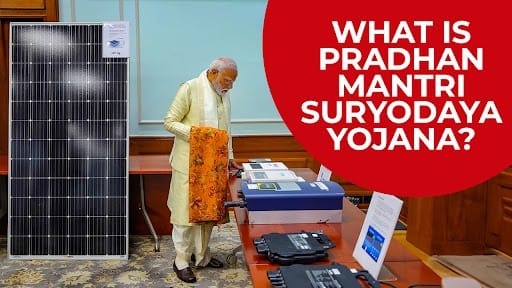Prime Minister Narendra Modi launched the ‘Pradhanmantri Suryoday Yojana,’ offering free rooftop solar to 10 million households. Know the cost savings and the benefits under the scheme.

Prime Minister Narendra Modi on January 23, 2024 announced the initiation of the ‘Pradhanmantri Suryoday Yojana,’ aiming to provide free rooftop solar installations to 10 million households in the country.
“This will not only reduce the electricity bill of the poor and middle class, but will also make India self-reliant in the energy sector,” he said.
At present, only citizens in the below poverty line (BPL) category are eligible for the scheme.
Solar Roof Tops
Rooftop solar panels, known as photovoltaic (PV) panels, are installed on building rooftops, seamlessly integrating it with the main power grid. This installation reduces reliance on grid-connected electricity, leading to cost savings for consumers. Electricity generated from the rooftop solar system can be used to meet the buildings’ energy demand, charge batteries for later use, or can be exported to the electricity Grid.
Costs And Savings
A solar rooftop system only incurs initial capital investment and maintenance costs.
Installation expenses typically range from Rs 1.5 lakh to Rs 3.5 lakh for an average household requiring 3-5KW setup.
At present, solar PV cell and module prices are at their lowest in the last one-and-a-half years, according to a government statement. A study co-organised by the Gujarat State Electricity Regulation Board and Gujarat Urja Vikas Nigam Limited (GUVNL) in December 2023 found that 43 per cent of the households which installed rooftop solar in the state saw a minimum reduction of Rs 1,000 per month in their power bills.
Here’s the impact of a solar rooftop on a consumer’s electricity bill using a simple example. Imagine a consumer instals a 1 kWp rooftop solar system. Assume that the average residential grid tariff is Rs 5 per kWh, and the solar system generates 4 kWh per day per kWp.
Case-1: Monthly Consumption Exceeds Solar Power Production
If the usual monthly consumption is 150 kWh, costing Rs. 750, and the solar system generates 120 kWh (30 days x 4 kWh), the net units consumed for the month would be 30 kWh. Under the net metering policy, the consumer is charged for only these 30 units, i.e., Rs. 150. This results in a total monthly saving of Rs. 600 on the electricity bill.
Case-2: Monthly Consumption Is Less Than Solar Power Production
If the usual monthly consumption is 100 kWh, and the solar system generates 120 kWh, the consumer’s net units consumed would be nil, with 20 units that can be exported back to the grid. In this case, the consumer is not charged for any units. The DISCOM may or may not compensate for the 20 units exported, based on particular state regulations.
Current Status
The country’s progress on this front has not been stellar, with only 700,000-800,000 households currently powered by solar energy.
The government has set a target of 40 GW annual solar power generation for the next five years to reach a 500 GW non-fossil fuel capacity target by 2030. Cumulative installed capacity in the rooftop solar segment in the country has crossed 10 GW as of December 2023.